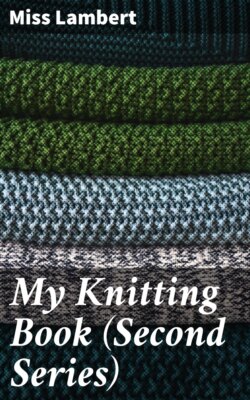Читать книгу My Knitting Book (Second Series) - Miss Lambert - Страница 4
ОглавлениеMY KNITTING BOOK.
SECOND SERIES.
Introduction.
It has been justly observed that, “an art cannot be taught but by its proper terms.” In the art of knitting, various terms have been employed—whether correctly, or not, it is here needless to inquire—to designate the same simple process. Confusion has necessarily been the result. Those who are accustomed to follow the technicalities of one writer on knitting, are not unfrequently perplexed to comprehend the directions of another, however clearly and concisely they may be laid down. Hence, in the first series of the present treatises, the writer confined herself to the use of the technical terms most generally employed by adepts in the art, and which appeared to be those most easy of comprehension. The following directions, therefore, will be conveyed in the same phraseology; but, for ease of reference, and for the use of those who may not possess the former series, it has been deemed expedient to repeat the—
Explanation of Terms used in Knitting.
To cast on.—To make the first interlacement of the thread on the needle.
To cast off.—To knit two stitches, and to pass the first over the second, and so on, to the last stitch, which is to be secured by drawing the thread through.
To pearl.—To knit a stitch with the thread before the needle.
To narrow.—To lessen, by knitting two stitches together.
To widen.—To increase by making a stitch, bringing the cotton round the needle, and knitting the same when it occurs.
A Turn.—Two rows in the same stitch, backwards and forwards.
A Row.—The stitches from one end of the needle to the other.
A Round.—A row, when the stitches are on two, three, or more needles.
A plain Row.—That composed of simple knitting.
To pearl a Row.—To knit with the thread before the needle.
To rib.—To work alternate rows of plain, and pearl, knitting.
To bring the thread forward.—To make a stitch, by bringing the thread forward, after a knitted stitch.
To pass the thread over.—To make a stitch, by passing the thread over the needle, after a pearled stitch.
To make a stitch.—If after a knitted stitch, this is done by bringing the thread forward;—if after a pearled stitch,—by passing the thread over.—To make a stitch between two pearled stitches, the thread must be turned round the needle; that is,—passed over the needle, and brought again in front; but, to make a stitch between a pearled stitch and a knitted stitch,—the thread must only be passed over the needle.
To turn the thread round the needle.—If the thread is before the needle, to pass it over the needle, and bring it again in front.
To bring the thread forward twice.—To bring the thread forward, and then, by turning it round the needle, to bring it forward again.
To increase.—To make a stitch.
To decrease.—To knit two stitches, taken together, in one.
To knit two together.—To knit two stitches, taken together, in one.
Knitting and pearling in the same row.—When the stitch, next after a pearled stitch, is to be knitted, it is obvious that the thread must be passed back under the needle, before this can be done;—in like manner, when a stitch is to be pearled, after a knitted stitch, the thread must be brought in front under the needle;—processes, however, very different from those of passing the thread over, and bringing the thread forward, both of which are for the purpose of making a stitch, and are done above the needle.
To slip, or pass a stitch.—To change it from one needle to the other, without knitting it.
To fasten on.—The best way to fasten on, is to place the two ends contrariwise, and knit a few stitches with both together: but, when knitting with silk, or fine cotton, a weaver’s knot will be found the best.
A Loop Stitch.—Made by bringing the thread before the needle, which, in knitting the succeeding stitch, will again take its own place.
Pearl, seam, and rib-stitch.—All signify the same.
It appears almost unnecessary to observe that, in some of the directions, in order to avoid repetition, the following mode of abbreviation has been adopted.—When a part of a row, or round, only is to be repeated, it is separated from the preceding part, by a letter of the alphabet, inserted in smaller type, between two brackets; thus,—repeat from (a) signifies that the part placed next after (a) alone is to be repeated. Further, to prevent confusion, when it was necessary to employ such an abbreviation more than once in the same directions, the other letters of the alphabet, in a similar manner, have been taken in their order of succession.
N.B. The sizes of the needles are given according to the Standard Filière.
It is necessary, in giving or following directions for knitting, to caution knitters to observe a medium in their work—not knitting either too loosely or too tightly.
The Standard Filière.
[THE STANDARD FILIÈRE.]
The above engraving represents the Standard Filière, or knitting and netting needle guage, an instrument invented some time since by Miss Lambert, and now in general use, by which the different sizes of knitting and netting needles can be ascertained with the greatest accuracy.
